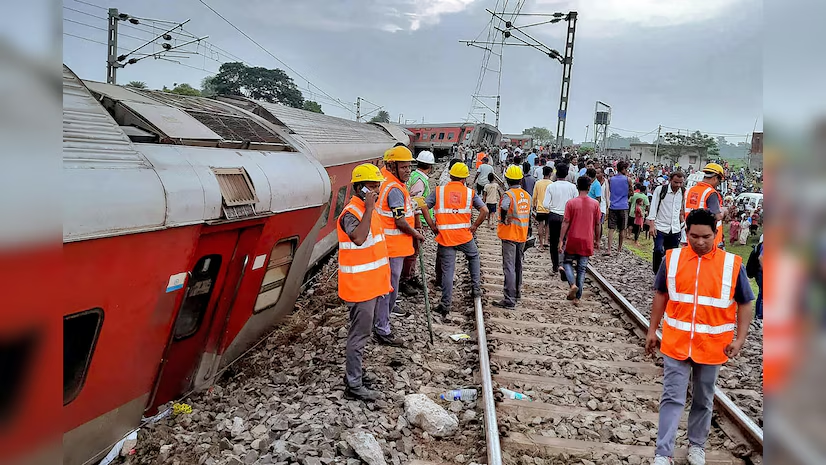A Year of Tragedy: An Overview
Since the beginning of 2024, India has witnessed a series of devastating train accidents that have claimed numerous lives and caused significant injuries. The incidents have varied in nature, including derailments, collisions, and fires, each contributing to the rising toll. The most recent tragedy, the Mumbai-Howrah Mail accident, has once again brought the issue of rail safety to the forefront.
- The Mumbai-Howrah Mail Accident: On July 29, 2024, the Mumbai-Howrah Mail derailed near a remote stretch of railway track, leading to a horrific accident that resulted in over 50 fatalities and dozens of injuries. The train was en route from Mumbai to Howrah when it veered off the tracks due to suspected track damage exacerbated by heavy rainfall. The accident has been described as one of the deadliest in recent years, prompting an immediate investigation and nationwide scrutiny.
- Notable Accidents Since January 2024:
- January 15, 2024: A collision between two passenger trains in Uttar Pradesh resulted in 20 deaths and more than 100 injuries. The accident occurred at an unmanned crossing where one train failed to stop, leading to a catastrophic collision.
- March 5, 2024: In Madhya Pradesh, a derailment of a freight train led to the deaths of 18 people, including railway staff and local residents. The derailment was attributed to track fractures caused by inadequate maintenance.
- May 12, 2024: A fire broke out in a passenger train traveling through Bihar, killing 15 passengers and injuring many others. The blaze was believed to have started from an electrical fault in the train’s engine.
- June 22, 2024: A train crash in West Bengal involved a passenger train colliding with a stationary goods train, resulting in 30 fatalities and significant damage. Preliminary investigations suggested signaling errors as a possible cause.
Causes Behind the Accidents
The spate of accidents has been attributed to various factors, including:
- Infrastructure Issues: A significant number of accidents have been linked to deteriorating railway infrastructure. Poorly maintained tracks, outdated signaling systems, and inadequate safety measures have contributed to the frequency and severity of accidents. Reports suggest that the maintenance of railway tracks and signaling systems often falls short of required standards, leading to catastrophic failures.
- Human Error: In several instances, human error has been a contributing factor. Errors in signaling, miscommunication between train operators and control centers, and lapses in adherence to safety protocols have played roles in these tragedies. The complexity of managing a vast railway network often leads to errors that can have fatal consequences.
- Weather Conditions: Adverse weather conditions, such as heavy rainfall and flooding, have exacerbated the risk of accidents. The Mumbai-Howrah Mail accident, for instance, was partly attributed to track damage due to heavy rains. Weather-related disruptions highlight the need for enhanced safety measures and infrastructure resilience.
- Technological Shortcomings: The integration of modern safety technologies, such as automatic train protection systems, has been slow. Many accidents have occurred in areas where such technologies were not implemented, underscoring the need for technological upgrades to improve safety.
Implications of the Recent Accidents
The recent spate of fatal accidents has far-reaching implications for Indian Railways and the broader transportation sector:
- Public Safety Concerns: The increasing number of accidents raises serious concerns about the safety of passengers. The public’s confidence in railway travel is eroded by frequent reports of accidents, leading to calls for immediate reforms and improvements in safety protocols.
- Economic Impact: Train accidents not only result in loss of life and injuries but also have economic repercussions. The costs of repairing damaged infrastructure, compensating victims, and addressing legal claims can be substantial. Additionally, accidents disrupt the flow of goods and passengers, affecting economic activities.
- Regulatory Scrutiny: The series of accidents has drawn significant attention from regulators and policymakers. There is growing pressure on the Indian Railways to address safety lapses, enhance infrastructure, and implement robust safety measures to prevent future tragedies.
The Path Forward: Addressing the Crisis
To address the crisis and prevent further tragedies, several measures need to be taken:
- Infrastructure Upgrades: A comprehensive assessment of railway infrastructure is essential. Investment in modernizing tracks, signaling systems, and stations can significantly reduce the risk of accidents. Regular maintenance and timely repairs are crucial to ensuring safety.
- Enhanced Safety Protocols: Implementing and enforcing stringent safety protocols can help mitigate human error. Training programs for railway staff, improved communication systems, and adherence to safety standards are vital components of a robust safety framework.
- Technological Advancements: Accelerating the adoption of advanced safety technologies, such as automatic train control systems and real-time monitoring, can enhance the safety of railway operations. Investing in technology can help detect and prevent potential hazards before they lead to accidents.
- Emergency Preparedness: Improving emergency response capabilities is crucial for managing the aftermath of accidents. Ensuring that rescue operations are efficient and well-coordinated can minimize casualties and provide timely assistance to victims.
- Policy Reforms: Regulatory bodies must strengthen oversight and enforce compliance with safety standards. Transparent investigations into accidents and accountability for lapses are necessary to drive improvements in the railway sector.
Conclusion
The recent spate of fatal train accidents in India underscores the urgent need for comprehensive reforms in railway safety and infrastructure. As the country grapples with the aftermath of these tragedies, it is imperative to address the underlying causes and implement effective measures to prevent future accidents. Ensuring the safety of millions of passengers who rely on the railway system daily requires a concerted effort from policymakers, regulators, and railway authorities. By prioritizing safety, investing in infrastructure, and embracing technological advancements, India can work towards a safer and more reliable railway network for all.





